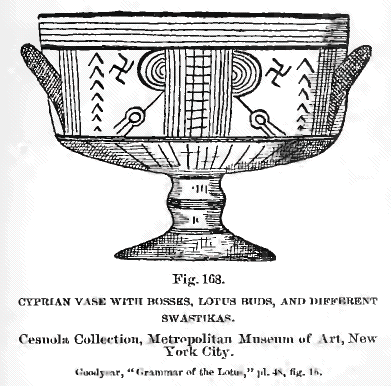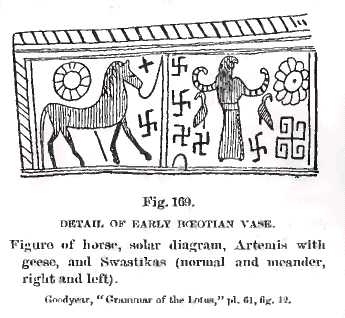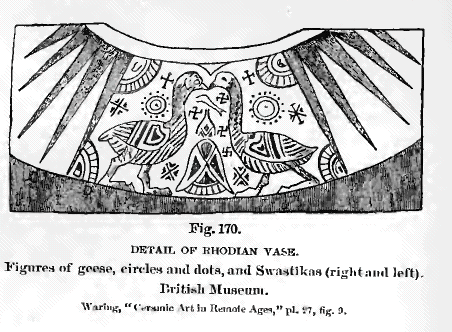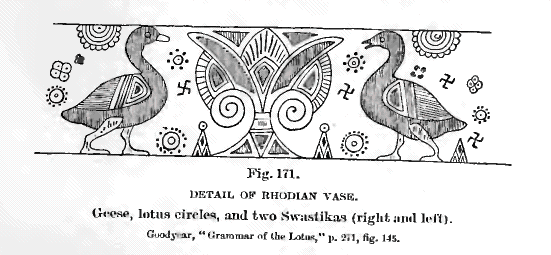|
The Swastika
Dispersion of the Swastika
Page 55
Greek Archipelago. This island
was first inhabited by the Phenicians, afterwards by the Greeks, a colony
of whom founded Cyrene in Africa. This specimen is cited by Rochette and
figured by Waring. (1)

Swastika with four arms, crossing
at other than right angles, the ends ogee and to the left. --- Figs.
158, 159, and 160
show Swastikas with four arms crossing at other than right angles, many
of them ogee, but turned to the left. Fig.
161 is a representation of a wooden button or clasp, much resembling
the later gold brooch of Sweden, classified by Montelius (p. 867), covered
with plates of gold, from Sepulcher IV, Mycenæ (Schleimann, Mycenæ,
fig. 385, p. 259). The ornament in its center is one of the ogee Swastikas with four arms (tetraskelion)
curved to the left. It shows a dot in each of the four angles of the cross
similar to the Suavastika of Max Müller and the Croix swasticale
of Zmigrodzki, which Burnouf attributed to the four nails which fastened
the cross Arani (the female principle), while the Pramantha
(the male), produced, by rotation, the holy fire from the sacred cross.
An almost exact reproduction of this Swastika will be found on the shield
of the Pima Indians of New Mexico (fig.
258).
its center is one of the ogee Swastikas with four arms (tetraskelion)
curved to the left. It shows a dot in each of the four angles of the cross
similar to the Suavastika of Max Müller and the Croix swasticale
of Zmigrodzki, which Burnouf attributed to the four nails which fastened
the cross Arani (the female principle), while the Pramantha
(the male), produced, by rotation, the holy fire from the sacred cross.
An almost exact reproduction of this Swastika will be found on the shield
of the Pima Indians of New Mexico (fig.
258).
He also reports (2)
that Swastikas (turned both ways) may be seen in the Royal Museum at Berlin
incised on a balustrade relief of the hall which surrounded the temple
of Athene at Pergamos. Fig. 162
represents a spiral Swastika with four arms crossing at right angles,
the ends all turned to the left and each one forming a spiral.

Waring (3)
figures and describes a Grecian oinochoë from Camirus, Rhodes, dating,
as he says from 700 to 500 B. C., on which is a band of decoration similar
to fig. 130. It is about 10
inches high, of cream color, with ornamentation of dark brown. Two ibexes
follow each other with an ogee spiral Swastika between the forelegs of
one.
Meander pattern, with ends bent
to right and left. --- Figs.
163, 164, and 165
show the Swastika in meander pattern. Fig.
163 shows two Swastikas, the arms of both bent to the right, one six,
the other nine times. The Swastika shown in fig.
164 is bent to the right, one six, the other nine times. The Swastika
shown in fig. 164 is bent to
the right eight times. That shown in fig.
165 bends to the left eight times.

Swastika
of different kinds on the same object. --- The next group (figs.
167, 168, 169,
170, 171,
172, 173,
174, 175
and 176) is of importance in
that it represents objects which, bearing the normal Swastika, also show
on the same object other styles of Swastika, those turned to the left
at right angles, those at other than right angles, and those which are
spiral or meander. The presence on a single object of different forms
of Swastika is considered as evidence of their chronologic identity and
their consequent relation to each other, showing them to be all the same
sign --- that is, they were all Swastikas, whether the arms were bent
to the right or to the left, ogee or in curves, at right angles or at
other than right angles, in spirals in the the London, Paris, and New
York museums, and in other collections. (See figs.
149, 159.) Fig.
174 shows an Attic painted vase (Lebes) of the Archaic period,
from Athens. It is a pale yellowish ground, probably the
ENDNOTES:
1.
"Ceramic Art in Remote Ages," pl. 42, fig. 2. [Back]
2. "Troja," p. 123. Back
3. "Ceramic Art in Remote Ages," frontispiece,
fig. 3, and p. 115. H. Mis. 90, pt. 2---54 Back
<< Previous Page
Next
Page >>
© 2004-2007 Northvegr.
Most of the material on this site is in the public domain. However, many people have worked very hard to bring these texts to you so if you do use the work, we would appreciate it if you could give credit to both the Northvegr site and to the individuals who worked to bring you these texts. A small number of texts are copyrighted and cannot be used without the author's permission. Any text that is copyrighted will have a clear notation of such on the main index page for that text. Inquiries
can be sent to info@northvegr.org.
Northvegr™ and the Northvegr symbol are trademarks and service marks
of the Northvegr Foundation.
|
> Northvegr™ Foundation
>> About Northvegr Foundation
>> What's New
>> Contact Info
>> Link to Us
>> E-mail Updates
>> Links
>> Mailing Lists
>> Statement of Purpose
>> Socio-Political Stance
>> Donate
> The Vík - Online Store
>> More Norse Merchandise
> Advertise With Us
> Heithni
>> Books & Articles
>> Trúlög
>> Sögumál
>>
Heithinn Date Calculator
>> Recommended Reading
>>
The 30 Northern Virtues
> Recommended Heithinn Faith Organizations
>> Alfaleith.org
> NESP
>> Transcribe Texts
>> Translate Texts
>> HTML Coding
>> PDF Construction
> N. European Studies
>> Texts
>> Texts in PDF Format
>> NESP Reviews
>> Germanic Sources
>> Roman Scandinavia
>> Maps
> Language Resources
>> Zoëga Old Icelandic Dict.
>> Cleasby-Vigfusson Dictionary
>> Sweet's Old Icelandic Primer
>> Old Icelandic Grammar
>> Holy Language Lexicon
>> Old English Lexicon
>> Gothic Grammar Project
>> Old English Project
>> Language Resources
> Northern Family
>> Northern Fairy Tales
>> Norse-ery Rhymes
>>
Children's Books/Links
>> Tafl
>> Northern Recipes
>> Kubb
> Other Sections
>> The Holy Fylfot
>> Tradition Roots

Please Visit Our Sponsors
- Référencement
- Alfaleith.org - Heithni, Viðartrú
- Odin's Journey
- Baman - Iceland/Aboriginal Australia
- Biker's Booty
- Création site Internet Paris
- Pagan T-shirts
- Appartements
- Chalets au Québec
- Logo Designers
- Web Design
- Appartements Montreal
- Espace Bureau Montreal
- London Tours
- Spanish Property Legal Advice
- Multi Pret Hypotheque
- Company Logo Design
- Wiccan T-shirts
- Art Gallery, Painting artists
- free logo design reviews
- Heathen, Heathenism, Norse Pagan
- Logo design by LogoBee
- Pagan Shirts
- Norse Pagan Religion
- Triumph, BSA, Norton, Euro Motorcycles - Accessories
- Logo Maker
- Logo Design - Business Logos, Inc.
- Logo Design - Logo Maker
- Create A Website
- Wiccan Shirts
- Mortgages
- Multi-Prêts Hypothèques
- Viking T-shirts
- Hewlett Packard Ink Cartridges
- Indian Recipes
- Logo Design London
- Logo Design
- Logo Design UK
- Subvention et financement PME
- Heathen T-shirts
- Medical Alert, Emergency response
- orlando hotels
- Slot Machines for Vikings
- Norse Pagan Clothing and Merchandise
- New Homes
- Branding Irons
- Bachelor Degree Online
- Online Degree
- College Degree
- Heathen, Viking and Norse Texts
- Création site Internet
- Montreal Web Design
- Free Dish Network Satellite TV
- Discount ink cartridge & laser cartridge
- DUI Lawyers & DWI Attorneys
- Promotional Products
- Ready-Made Company Logos
- Canadian Art Dealer
- Best CD Rates
- Laser Toner Cartridge
- Logotyper & Grafiska Profilprogram
- Banner Design
- Custom Logo Design
Web site design and coding by Golden Boar Creations
|
|



 its center is one of the ogee Swastikas with four arms (tetraskelion)
curved to the left. It shows a dot in each of the four angles of the cross
similar to the Suavastika of Max Müller and the Croix swasticale
of Zmigrodzki, which Burnouf attributed to the four nails which fastened
the cross Arani (the female principle), while the Pramantha
(the male), produced, by rotation, the holy fire from the sacred cross.
An almost exact reproduction of this Swastika will be found on the shield
of the Pima Indians of New Mexico (fig.
258).
its center is one of the ogee Swastikas with four arms (tetraskelion)
curved to the left. It shows a dot in each of the four angles of the cross
similar to the Suavastika of Max Müller and the Croix swasticale
of Zmigrodzki, which Burnouf attributed to the four nails which fastened
the cross Arani (the female principle), while the Pramantha
(the male), produced, by rotation, the holy fire from the sacred cross.
An almost exact reproduction of this Swastika will be found on the shield
of the Pima Indians of New Mexico (fig.
258).

